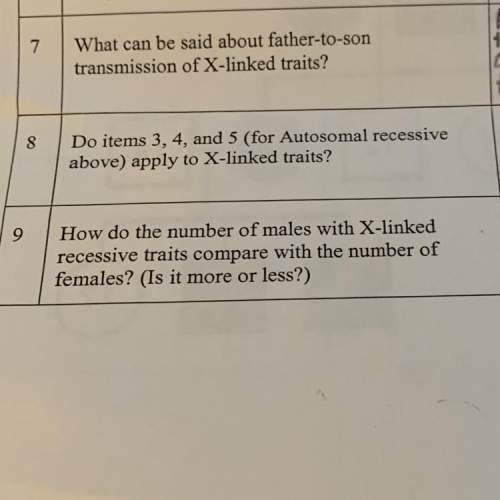Question 16 (3 points)
(01.01 MC)
A scientist is investigating the effects of salinity on fis...

Biology, 25.09.2020 09:01, Sumthin4695
Question 16 (3 points)
(01.01 MC)
A scientist is investigating the effects of salinity on fish development. He places fertilized fish eggs in an aquarium that contains low salinity and observes their development. What factor would improve experimental design the most? (3 points)
a
Place the fish eggs in the open ocean because that is the natural habitat
b
Include another aquarium that has normal salinity to compare to the low salinity aquarium
c
Include an aquarium that replaces salt with sugar to confirm that the effects are specific to salt
d
Grow algae with the fish eggs in order to provide adequate nutrients to the developing embryos
Question 17 (3 points)
(01.02 MC)
A diver is swimming near the surface of the ocean. What would she most likely observe, in terms of the numbers of photosynthetic organisms and light conditions? (3 points)
a
Few photosynthetic organisms and very little light
b
Many photosynthetic organisms and very little light
c
Few photosynthetic organisms and large amounts of light
d
Many photosynthetic organisms and large amounts of light
Question 18 (3 points)
(01.04 LC)
What property of water allows fish to survive in a lake that is frozen over? (3 points)
a
High boiling point
b
Low density as a solid
c
Low vapor pressure
d
High heat capacity
Question 19 (3 points)
(01.01 MC)
Students in a high school Marine Science class are learning about the scientific process. Four students were asked to write a testable prediction about ocean temperature. Their responses are shown in the chart.
Student Response
Kyle Ocean temperatures are 22°C in the summer.
Xavier The salt in oceans causes the temperature to be colder in the summer than in the winter.
Rose The ocean temperatures were colder prior to the existence of bony fish.
Laurie Ocean temperatures must remain constant in order to go surfing.
Which student's prediction is the most testable using the scientific process? (3 points)
a
Kyle
b
Xavier
c
Rosa
d
Laurie
Question 20 (3 points)
(01.03 MC)
Shrimp are primary consumers that feed on photosynthetic organisms. Why would these organisms likely be found only in shallow ocean zones? (3 points)
a
The fast currents in deeper ocean zones would kill photosynthetic organisms.
b
The amount of oxygen in deeper ocean zones is too high for shrimp to breathe.
c
The amount of light in deeper ocean zones is too dim to support photosynthesis.
d
The high water pressure in deeper ocean zones would likely prevent photosynthesis.
Question 21 (3 points)
(01.03 MC)
During upwelling, nutrient-rich water rises to the surface. How would this most likely affect the biotic components of the ecosystems where the upwelling is taking place? (3 points)
a
Increase in species numbers and diversity
b
Decrease in currents and tides
c
Increase in salinity
d
Increase in temperature
Question 22 (3 points)
(01.03 MC)
In order to simulate epipelagic zone conditions in a model aquarium design, what light and temperature conditions would be required? (3 points)
a
Minimal amount of sunlight, warm temperature
b
High amount of sunlight, warm temperature
c
Minimal amount of sunlight, cold temperature
d
High amount of sunlight, cold temperature
Question 23 (3 points)
(01.01 MC)
A Japanese scientist observes that lobster shells are softer when the animals are exposed to low pH in an aquarium. He asks his colleague in the United States to conduct the same experiment using the same aquarium equipment. Should he expect the results to be similar? (3 points)
a
Yes, because American equipment should produce even more accurate measurements
b
Yes, because the same experiment should yield the same results as long as the environmental conditions are the same.
c
No, because the altitude between the two labs can be different, which would impact shell growth
d
No, because the two countries have different time zones, which would affect the sleep cycle of the lobsters
Question 24 (3 points)
(01.04 MC)
Sascha notices that water droplets on her car window sometimes join together to form a larger drop. What property of water is Sascha observing?(3 points)
a
Cohesion
b
Specific heat capacity
c
Heat of vaporization
d
Capillary action
Question 25 (3 points)
(01.04 MC)
Much of life on Earth is based in aquatic biomes. What property of water allows life to survive in liquid water? (3 points)
a
The lower density of ice causes it to float and allows life to continue in the liquid water below.
b
The high boiling point of water limits the depth at which ice can form.
c
The high heat capacity of water prevents any evaporation into the atmosphere.
d
The ability of water to act as a universal solvent makes all water equally habitable.

Answers: 2
Other questions on the subject: Biology

Biology, 22.06.2019 11:00, shikiaanthony
Draw the farm's ppf for corn and beef. draw a point that shows an inefficient combination of corn and beef. label ita. draw a point that shows an unattainable combination of corn and beef. label itb. draw a point that shows an efficient combination of corn and beef. label itc.
Answers: 2

Biology, 22.06.2019 13:30, iicekingmann
When the solution concentration on the outside of a cell is greater than thesolution concentrate on the inside of the cell, what type of solution is the cellwithin?
Answers: 1

Biology, 22.06.2019 15:10, Jadamachado45
Hairs that clean dirt out of the air in your nasal passages are called: a. sinus b. trachea c. cilia d. mucus
Answers: 2

Biology, 22.06.2019 16:30, supiine1405
Has magnification ability of hundreds of thousands of times
Answers: 1
Do you know the correct answer?
Questions in other subjects:

Advanced Placement (AP), 17.12.2020 06:30

Mathematics, 17.12.2020 06:30

English, 17.12.2020 06:30

Mathematics, 17.12.2020 06:30


Mathematics, 17.12.2020 06:30



Mathematics, 17.12.2020 06:30







